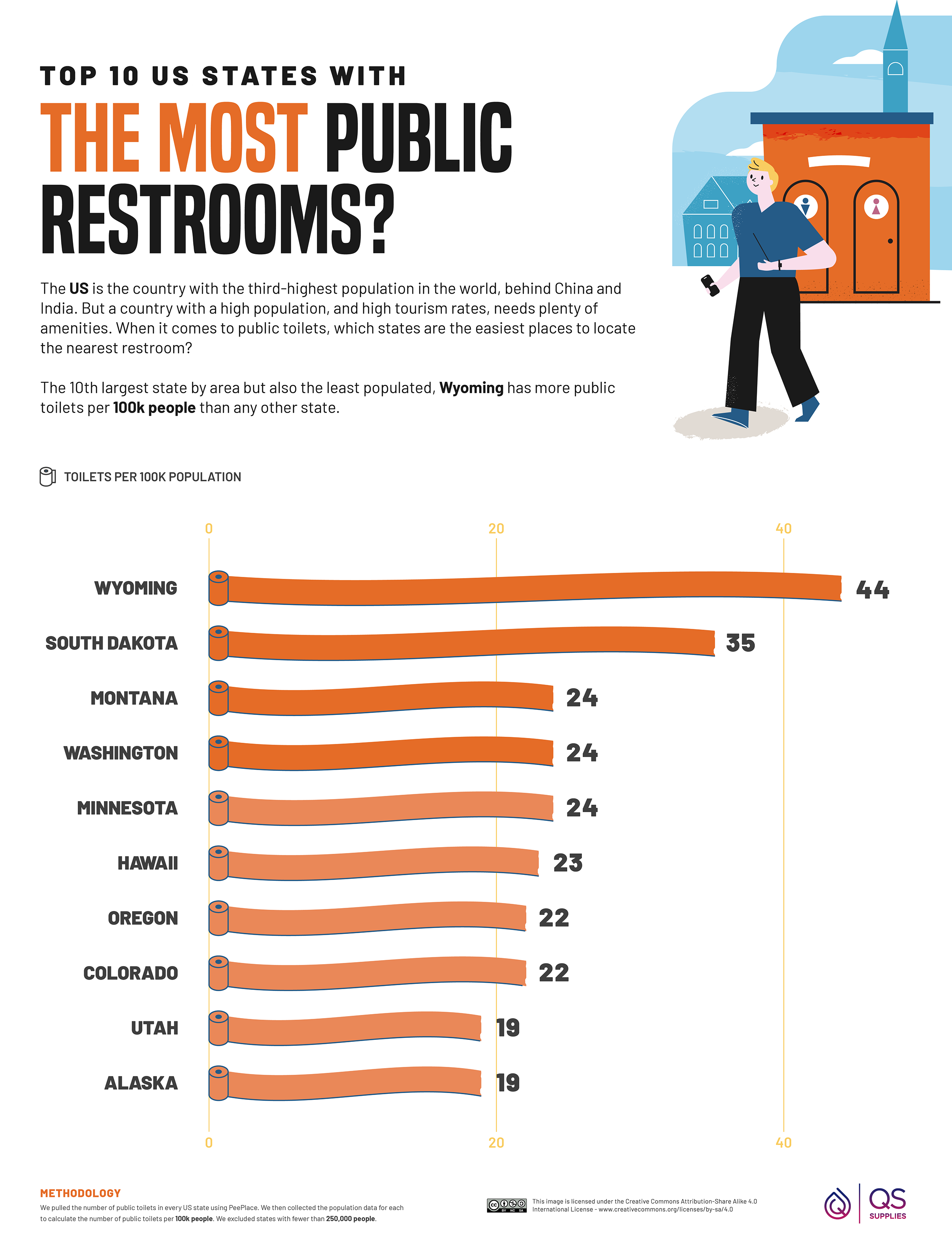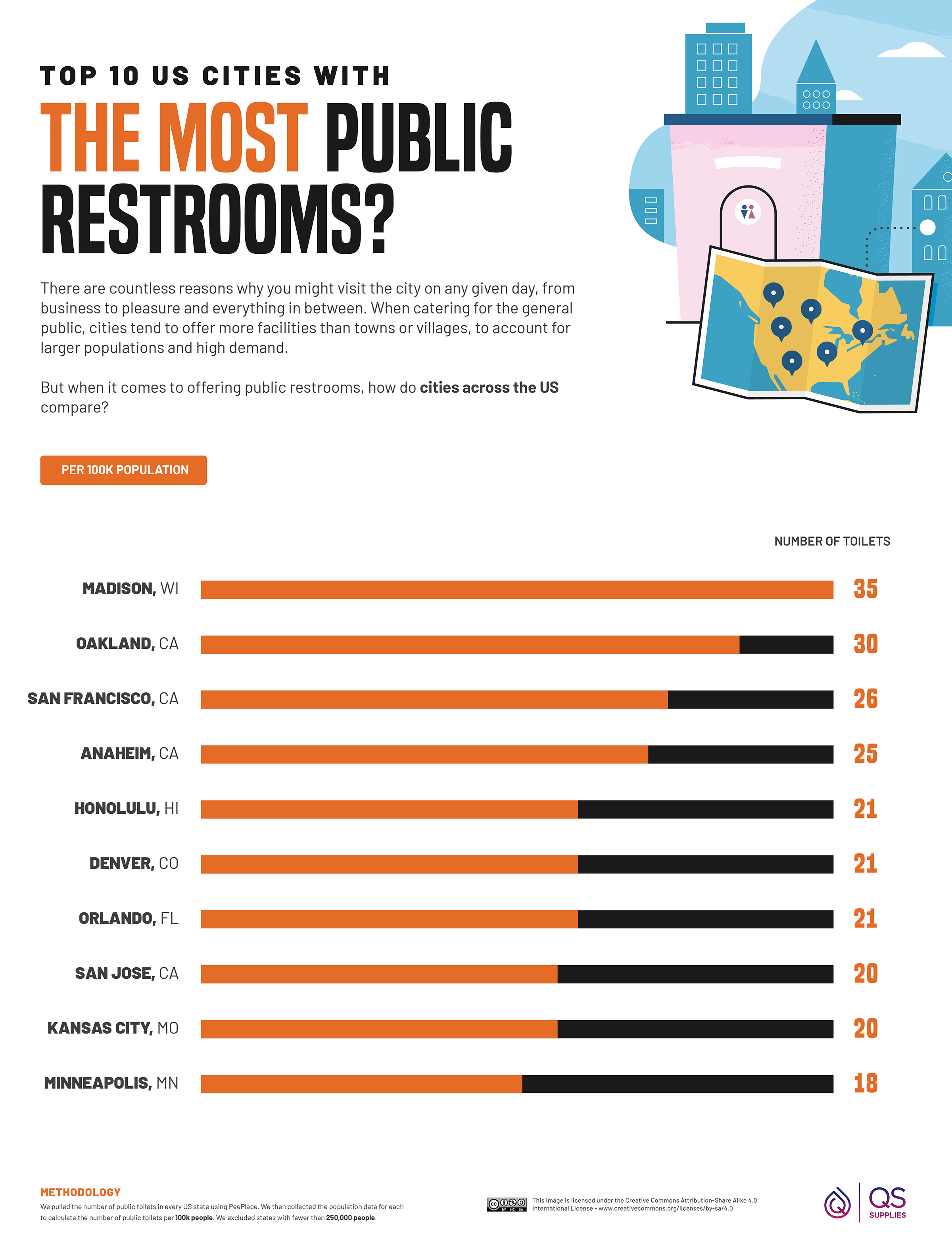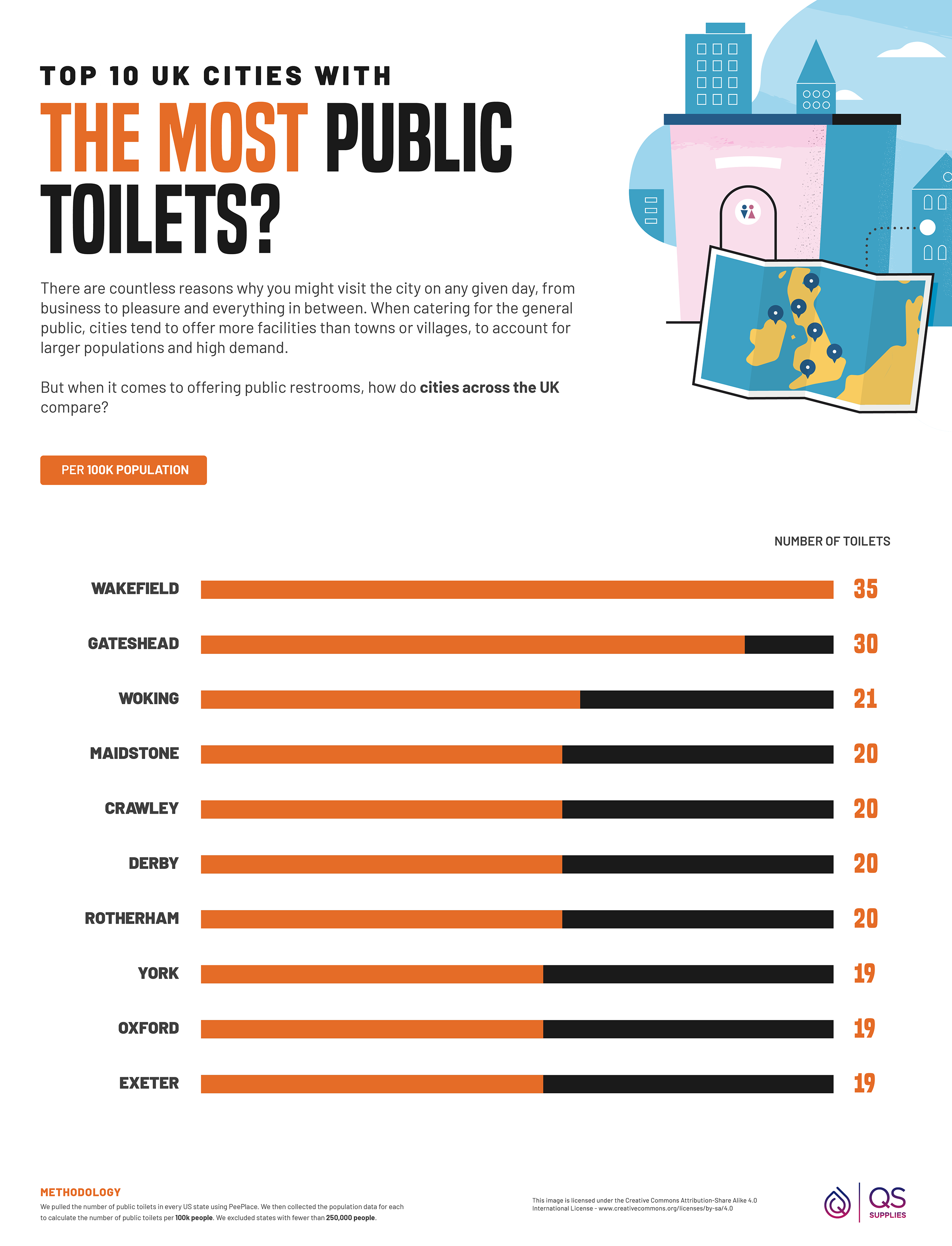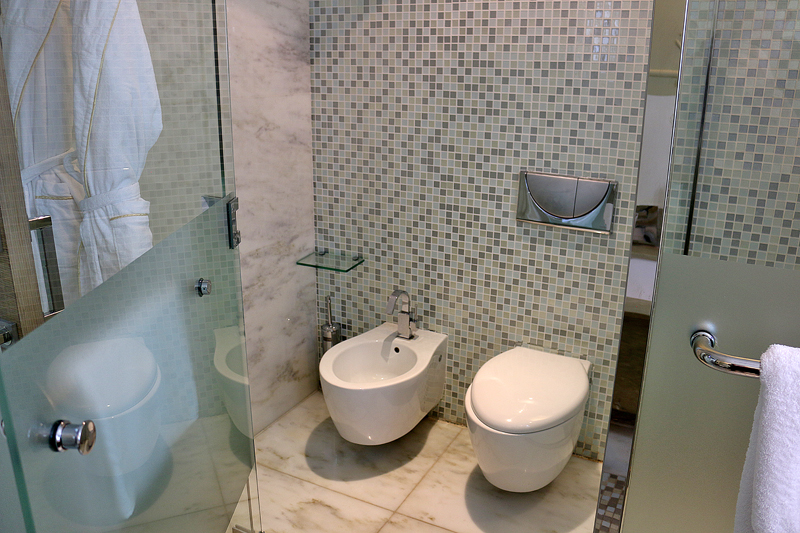Although ways do exist on how to reduce the number of times you need to use the toilet while traveling, you will never be able to eliminate the need — which brings us to the question: which cities have the most public toilets; and which cities have the fewest public toilets?
To answer that question, the number of public toilets in different cities throughout the UK and the US was pulled using PeePlace — yes, you read that correctly — which is an essential tool which is used to find toilets and to count the number of restrooms in different parts of the world. Only cities with a minimum of ten public toilets were included in the dataset. Then, the official population data of the United States and the United Kingdom was collected from ONS and Census to calculate the number of public toilets per 100,000 people. Using this data, the number of public toilets per 100 square kilometres in cities and counties in the United Kingdom and cities and states in the United States were worked out as well.
The data only includes countries with a minimum population of 300,000 people; cities of the United States with a minimum population of 250,000 people; and cities in the United Kingdom with a minimum population of 100,000 people.
Counties in the United Kingdom were taken as metropolitan and non-metropolitan counties in England, principal areas in Wales, council areas in Scotland, and counties of Northern Ireland. The City of London was removed from the dataset due to its special status and significantly smaller population.
The data was gathered in August 2021 — and additional charts have been included after the conclusion of this article below.
I have been given express written permission to use the maps and the verbatim text from this article from QS Supplies, which highlights which countries and cities have the most — and fewest — public toilets. This information is general in nature only and does not constitute personal advice. While QS Supplies has endeavored to ensure the information provided is accurate and current, it cannot guarantee it. Neither QS Supplies nor The Gate accept liability for the information which is presented in this article.
Public Toilets: Which Countries and Cities Have the Most — and Which Ones Have the Fewest?
When ‘nature calls,’ you don’t want to squat behind a tree to answer it. But even the most developed cities and towns are troublingly short on public toilets. And the issue is disproportionately more pressing on humanity’s less-privileged restroom users.
The homeless. The elderly. Pregnant women and new mothers. Many will have a sparse mental map of potential pee stops in their neighbourhoods. And those public bathrooms that do exist are often inaccessible to people with certain disabilities. “If I have to be thankful for an accessible bathroom,” asks disability rights activist Judy Heumann, “when am I ever gonna be equal in the community?”
But everyone needs the bathroom when out and about from time to time. So which cities and countries make it easiest to find a restroom?
Key Findings
- The country with the highest density of public bathrooms is Iceland: 56 toilets per 100,000 population.
- Wakefield is the UK city with the most restrooms per 100,000 people (35) and per 100km2 (130).
- Berkshire, Merseyside, and Greater Manchester are tied as the counties with the fewest toilets per 100k population (three).
- Madison, WI, is the US city with the most toilets per 100k (35).
- Mississippi and Louisiana each have just one restroom per 100k population, the worst-served states in America.
Wakefield (UK) and Madison (US) Are the Cities with the Most Restrooms
Our first restroom tool compares the restrooms in UK and US cities. Click the tabs to switch between countries, and use the dropdown menus to choose the cities you’d like to compare.
Wakefield takes the crown as the UK’s best place for public toilets. Or, more appropriately, it takes the throne – 38 thrones, actually, for its population of 107,546. The city’s success stands in stark contrast to its eponymous borough and nearby Yorkshire cities, where locals have been vocal about the lack of facilities.
Brighton and Hove come a close second to Wakefield when compared by distance. Wakefield has 130 restrooms per 100km2, while Brighton has 134. However, Brighton has far fewer restrooms per 100k population (16). In other words, you’re always near a public toilet in both cities – but in Brighton, you’re more likely to face a queue.
Four of the top 10 cities in the US for number of public restrooms per capita are in California: Oakland (30 toilets per 100,000 people), San Francisco (26), Anaheim (25), and San Jose (20). However, you’ll find the shortest queues in Madison, Wisconsin, where there are 35 public restrooms per 100,000 people.
San Francisco is also on top for toilets per 100km2 (18.7), far ahead of second-placed Oakland (8.8). The streets of Frisco are lined with self-cleaning toilets, which are run at zero cost to the city. Contractor JCDecaux is licensed to install public service/advertising kiosks on the pavements to recoup their costs.
Scottish Island Counties are Spoiled for Public Bathrooms
Here’s our public toilet map of UK counties, showing the number of restrooms per 100 population. The Scottish Orkney Islands are way out there with 216, followed by Na h-Eileanan Siar (the Outer Hebrides) with 153. The three counties with the highest density of restrooms each have a population of < 30,000 and plenty of toilets for each individual.

The only county in the top 30 with a population of more than 1m is Surrey, in 30th place with 24 bathrooms per 100k. And the three worst-attended counties each have a population of 900,000 or more: Berkshire, Merseyside, and Greater Manchester each have a toilet count of just 3 per 100k.
Following an outcry at Manchester’s frequent toilet closures, the British Toilet Association (BTA) has stepped in with a Use Our Loos campaign to encourage businesses to open up their bathrooms to non-customers.
Southern States Have A Single Restroom for Around 50,000 People
Smaller American states, like smaller UK counties, dominate the top of the restroom chart. Wyoming (pop. 578,759) boasts 43.9 bathrooms per 100k people. South Dakota is securely in second place with 35.4/100k. And here’s a tip if you’re caught short in Wyoming: it’s illegal for an establishment to charge you to use the bathroom. They can close their bathrooms to the public altogether if they want, but if they demand you make a purchase before you make a ‘visit,’ they’re in the wrong.
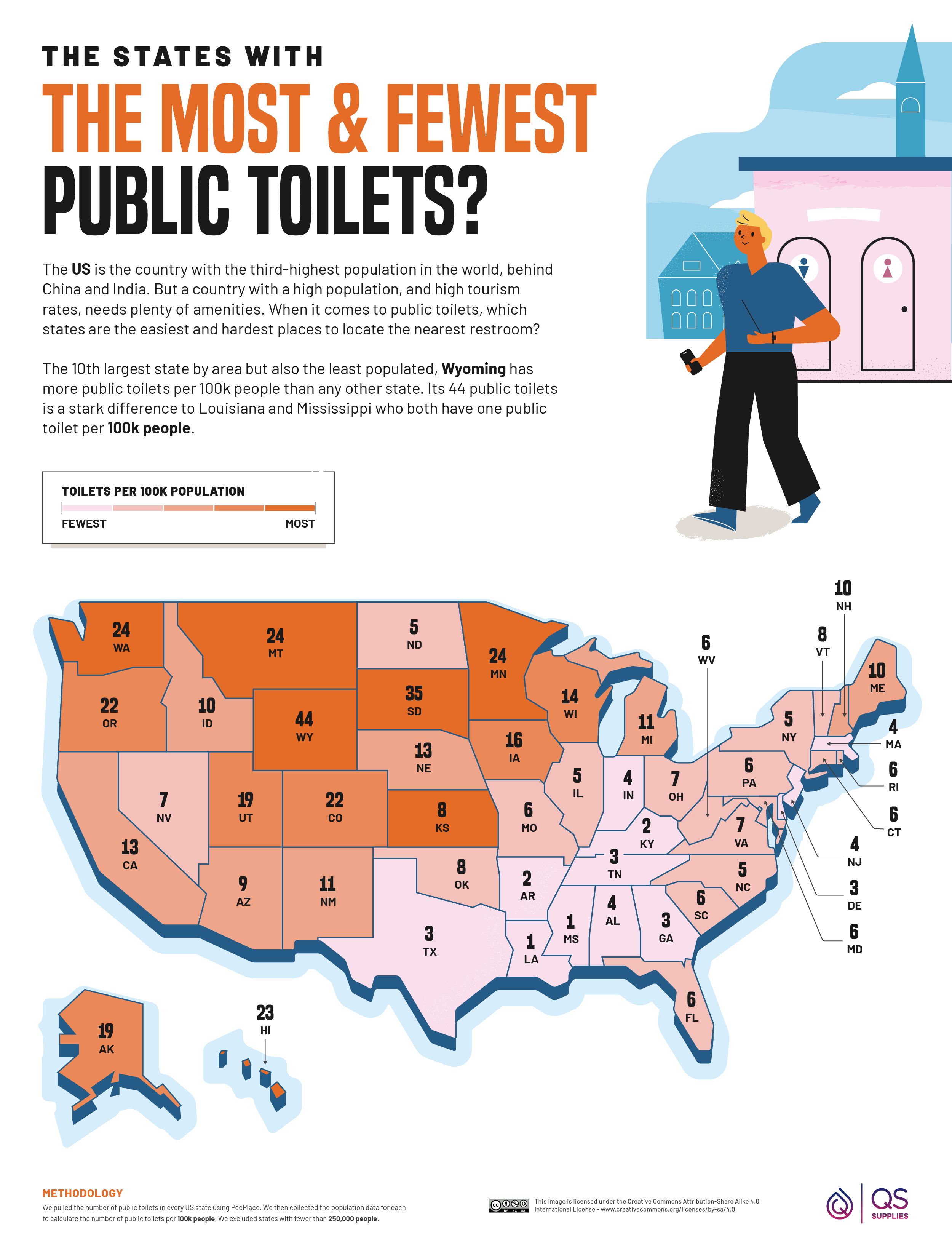
You really don’t want to be stuck down south if you have, um, trouble ‘down south.’ The six states with the fewest bathrooms per capita are Louisiana (1.2 per 100k), Mississippi (1.2), Kentucky (1.9), Arkansas (2.2), Texas (2.6), and Tennessee (2.8). From racial segregation to transgender rights, public restrooms have always been a political sore point for some.
Iceland Leads European Surge of Countries with High Restroom Availability
There’s good news and bad news if you need a pee on your European vacation. Our chart of restroom density in countries around the room is dominated by European cities. Seventeen of the top 20 countries for restroom availability are in Europe, and each of those promises at least 15 bathrooms per 100k population.
The rub is that European restrooms tend to have a nominal cover charge. Often, it’s €1 or less, but still – €1 may as well be a million bucks if your bladder’s bursting and you don’t have change.

New Zealand and Australia also make the top five. But it’s more of a mixed bag at the bottom, where countries from Africa, South America, Asia, and North America prop up the table with less than one bathroom per 100,000 people.
Restrooms: a Humanitarian Issue
Why aren’t there more restrooms? Vandalism, drug use, ‘misuse,’ and excessive mess are blamed for authorities’ failure to establish and maintain more public toilets. Restrooms require effort and money to function.
But ‘people who pee’ is a pretty big demographic. Advertisers and corporate sponsors would queue up to access the vacant attention of public bathroom users, if the infrastructural will was there. For example, designers in India have pioneered cost-effective and sustainable solutions such as building bathrooms in disused buses, using solar power, reusing water, and designing spaces that encourage respectful behaviour.
In short, peeing in public is a political issue. As long as those who need the service the most are the most underprivileged, it may take a concerted effort for progress on this humanitarian issue.
For the full data from our study, please check out the interactive table below at your convenience.
Final Boarding Call
“The first modern flushable toilet was described in 1596 by Sir John Harington, an English courtier and the godson of Queen Elizabeth I”, according to this article which was written by Nate Barksdale for History. “Harington’s device called for a 2-foot-deep oval bowl waterproofed with pitch, resin and wax and fed by water from an upstairs cistern. Flushing Harington’s pot required 7.5 gallons of water—a veritable torrent in the era before indoor plumbing. Harington noted that when water was scarce, up to 20 people could use his commode between flushes.”
Then, there is the legend of Thomas Crapper, whose last name is quite apropos with the toilet: “In 1861 Thomas Crapper started a plumbing and sanitary engineering business. He quickly gained a reputation for high quality work. As the business grew Thomas realised that there was a sizeable market for high quality bathrooms and toilets in addition to his services as a plumber. This led him to open the world’s very first bathroom showroom in 1870 to complement his plumbing services. Today we retain that same pride in the quality of product that Thomas himself set and now offer a wide range of exceptional bathroom products.”
You might be flushed with envy of people who have more access to public toilets…
…unless you are on a roll at avoiding public toilets as much as possible — but that can be draining.
I almost never use public toilets — while traveling or otherwise — tank you very much; but one trick is to head into a fast food restaurant and purchase something to eat in order to gain access to its toilet.
Come to think of it, I have often wondered why public toilets in the United States are in places which are known as rest rooms.
Other articles at The Gate which have to do with toilets include — but are not limited to:
- Trapped in the Toilet of My Hotel Room in Egypt
- Toilet Problems Forces Airplane Full of Plumbers to Turn Around
- No Toilet Paper During Transatlantic Flight?
- The Toilet That Wasn’t
- “I Have to Pay to Use the Toilet?!?”
Photograph ©2015 by Brian Cohen.
